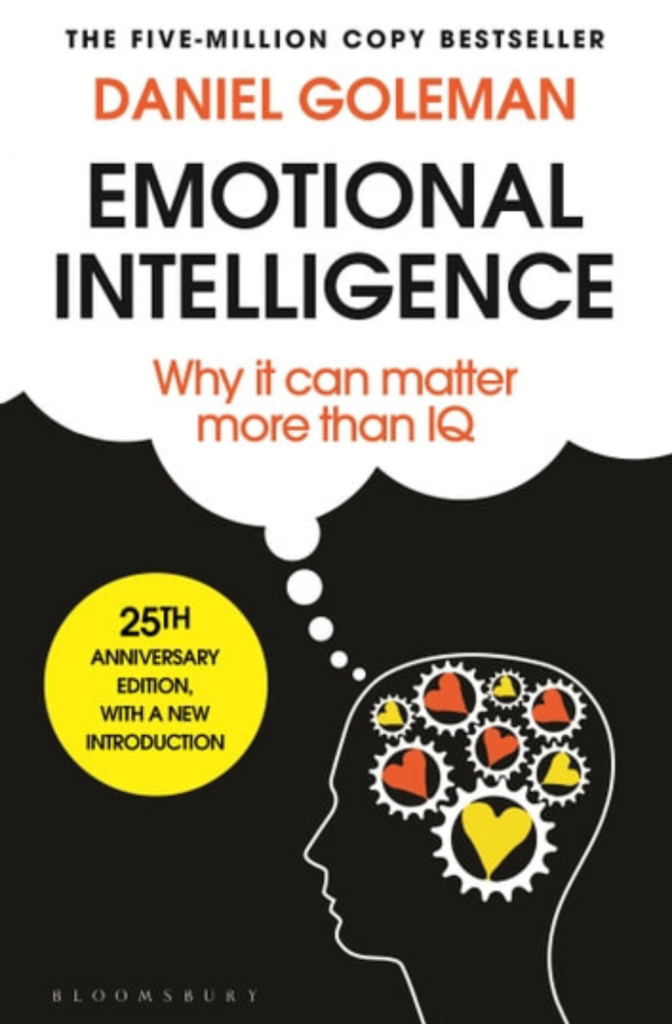Everyone thinks that a high IQ guarantees success or happiness but the intelligence quotient comes to nothing when emotions hold sway. Written by Daniel Goleman and published in 1990, Emotional Intelligence teaches you to be aware of your feelings with Intelligence and widen your circles of caring. With Emotional Intelligence, you can transform and build organisations to their total capacity. Making a positive difference around the world.
HOW THIS BOOK HELPED US?
Emotional Intelligence first explains what emotions are and then describes how we can control our feelings if we are angry. That anger should be a secondary reaction. The book also helped us be aware of our emotions as they arise and steps to take not to take us off our feet. Emotional Intelligence taught us that emotional differences can be biological and tracked back to childhood.
THE BOOK EXPLAINED IN UNDER 60 SECONDS

- Attention is put on emotional literacy; parents and teachers ought to teach and sensitise children on how to control their emotions because kids with emotional literacy can not opt for violence when angry.
- Emotional Intelligence describes emotions are primarily strong impulses that guide us in encountering difficult situations and tasks too essential to leave intellect alone. Painful loss, danger, or pushing toward a goal offer exceptional readiness to act regardless of the frustrations. Each emotion points you in a direction that is well experienced to handle the iterative challenges of human life.
- The writer emphasises self-awareness and tells you to be aware of your emotions as they arise. Self-awareness is not attention carried away by emotions, amplifying and overreacting, but rather a neutral mode that conserves self-reflectiveness even amongst unstable emotions.
TOP THREE QUOTES
- “Anyone can become angry—that is easy. But to be angry with the right person, to the right degree, at the right time, for the right purpose and in the right way—that is not easy.”
- “The range of what we think and do is limited by what we fail to notice. And because we fail to notice that we fail to notice there is little we can do to change until we notice how failing to notice shapes our thoughts and deeds.”
- “Emotional self-control, delaying gratification and stifling impulsiveness—underlies accomplishment of every sort.”
BOOK SUMMARY AND NOTES
PART ONE: THE EMOTIONAL BRAIN

Chapter one: What are Emotions for
Emotions are primarily strong impulses that guide us in encountering difficult situations and tasks too essential to leave intellect alone. Painful loss, danger, or pushing toward a goal offer a remarkable readiness to act regardless of the frustrations. Each emotion points you in a direction that is well experienced to handle the iterative challenges of human life. It’s sadly shortsighted that human nature tends to disregard the power of emotions. And, when it comes to shaping our decisions and actions, feeling tends to matter much more than thought. We emphasise the value of what IQ measures, yet Intelligence comes to nothing when emotions hold control.
Think about how the brain evolved to grasp better the incredible power of emotions on the thinking mind and why reason and feeling are willingly at war. Millions of years into the evolution, the thinking brain or neocortex evolved from emotions. The neocortex emerged from emotions; discloses much about the correlation between feeling and thought. There was an emotional brain way before there was a rational one.
Chapter two: Anatomy of an Emotional Hijacking
Humans tend to have emotional explosions when panicking or when angry. Such explosions are known as neural hijackings. At such moments, the pivot in the limbic brain signifies an urgent situation, recruiting the rest of the brain to its pressing agenda. The hijacking happens instantly, activating reactions to critical moments before the thinking brain or neocortex notes what is happening. Hijacks leave hallmarks behind that once the event passes, those so possessed don’t have the sense of knowing what came over them. Hijacks are not isolated or horrific events resulting in savage crime but rather happen to us reasonably. These hijacks originate from the amygdala—the centre of the limbic brain.
Favourite quote of part one: “Intelligence can come to nothing when the emotions hold sway.”
PART TWO: THE NATURE OF EMOTIONAL INTELLIGENCE

Chapter One: When Smart Is Dumb
One of psychology’s open secrets is the relative incapacity of grades to foretell errorlessly who succeeds in life regardless of their famous charisma. Yes, there is a correlation between life affairs and IQ. People with relatively low IQs usually end up in low-status jobs, and those with high IQs land well-paying jobs—but this is not always the case. There are many exceptions to the directive that IQ projects success, yet it contributes 20 per cent to your success in life. The vast majority of your success in society is insistent on non-IQ features, stretching from social class emotional Intelligence to luck.
Emotional Intelligence and IQ are not antagonising competencies but instead separate ones. We mix intellect and emotional keenness. People with high emotional intelligence but low IQ are, despite the stereotypes, scarce.
Chapter two: Know Thyself
You have to be aware of your emotions instead of being swept away by them as they arise. Be mindful of your feelings as they occur. Self-awareness involves self-observation, stepping away from your feelings and examining them with calm. Identifying and reviewing emotions as they come to light shifts your mental activities from the amygdala to the neocortex, making the unconscious conscious. A self-reflexive awareness mind observes and investigates itself, including emotions. Self-awareness is not attention carried away by emotions, amplifying and overreacting, but rather a neutral mode that conserves self-reflectiveness even amongst unstable emotions.
Chapter three: Passion’s Slaves
When people’s moods are averaged over a specific period, they mirror someone’s broad sense of well-being. Exceedingly intense feelings are rare for many; most people fall in the grey middle range, with gentle bumps in their emotional roller coaster. However, managing emotions is an entire job. Everything we do, particularly in our free time, is an effort to control our moods. Watching TV or going for a walk, the activities we choose can be a technique to control our temper. The art of soothing ourselves is an essential skill.
The Anatomy of Rage
Anger is one of the most demanding emotions to control, and people feel exceeding anger when threatened with psychological or physical danger. The energy surge gears up for a fight retaliation. We also possess the cortical and adrenal responses that call for immediate adverse reactions. The train of angry thoughts that mend anger is prospectively the key to one of the most influential courses of action to defuse anger—eroding the convictions driving the anger in the first place.
The longer you think about what made you angry, the more reasons and justifications for being angry you can create.
Favourite quote of part two: “There is perhaps no psychological skill more fundamental than resisting impulse. It is the root of all emotional self-control, since all emotions, by their very nature, lead to one or another impulse to act.”
PART THREE: EMOTIONAL INTELLIGENCE APPLIED

Chapter one: Intimate Enemies
Men and women in a relationship are two emotional realities in a couple. The roots of these emotional differences can be biological, and also tracked down back to childhood. To the separate emotional worlds, boys and girls inhabit while growing up. When growing up, boys and girls are educated differently on handling emotions. In general, parents talk about feelings excluding anger—often with their daughters than their sons, revealing more emotions to the girls than boys.
Consider the implications of an emotional gap for controlling the disagreements that any passionate relationship inevitably spawns. How a couple discusses painful points matters much more for the fate of their marriage. Arriving at a consensus about how to disagree is essential for marital survival.
Chapter two: Managing With Heart
When people work jointly as a group, every individual puts specific talents such as high verbal fluency, empathy, creativity and technical expertise on the table. A group can be no more intelligent than the total of all these particular strengths. It can also be dumber if its internal workings don’t permit individuals to share and express their talent.
The inspection of informal networks reveals that just because people work together daily will not trust each other with sensitive information like the need to switch jobs, being displeased with how a coworker behaves or turning to them in case of an emergency.
Favourite quote of part three: “Leadership is not domination, but the art of persuading people to work toward a common goal.”
PART FOUR: WINDOWS OF OPPORTUNITY

Chapter one: The Family Crucible
When a child is subjected to painful moments such as beating, they might think that neither their parents nor family members care about their feelings. When similar situations are iterative throughout childhood, they convey principal emotional messages—lessons that can influence the child’s life course. Family is the first school for feelings, how to be under the impression of these feelings, and what decisions you make in reacting. This emotional schooling utilises what parents do and say to you and the models they offer for handling their emotions and those that pass between husband and wife.
Chapter two: Trauma and Emotional Learning
Any traumatising moment such as an accident, a fire outbreak, or a natural catastrophe like a hurricane, can trigger memories in the amygdala. Each year, thousands of people encounter and endure such tragedies. Nearly all of them go away with the type of emotional damage that leaves its mark on the brain. In most instances, violent deeds are more detrimental to one’s emotional health than natural calamities such as earthquakes. Unlike casualties of a natural disaster, victims of violence feel they were intentionally designated as the target of the malice. Human cruelties leave a hallmark on the memory of their victims that regards anything similar to the assault itself.
Emotional Learning
Distressing memories tend to remain attachments in the brain since they hinder successive learning—especially when relearning a more typical response to those traumatising events. In obtaining fear like PTSD, the procedures of memory and learning go wrong. Again, it is the amygdala that is essential among the brain regions involved. But in getting control of the acquired fear, the neocortex is crucial.
The process by which something that is not in the slightest threatening becomes dreaded as it is related to someone’s mind with something frightening is known as fear conditioning. Ordinarily, when you learn to be terrified by something through fear conditioning, the fear falls away with time. This occurs through natural relearning as the feared element is encountered repeatedly in the truancy of something scary.
Favourite quote of part four: “Any traumatising moment such as an accident, a fire outbreak or a natural catastrophe like a hurricane can insert trigger memories in the amygdala.”
PART FIVE: EMOTIONAL LITERACY

Chapter one: The Cost of Emotional Illiteracy
Educators have been bothered by schoolers’ lagging scores in reading, math and science, not noticing a more alarming and different deficiency: emotional illiteracy. While commendable endeavours are being put in place to elevate academic standards, this new agitating deficiency is not being addressed in the school curriculum. The emphasis in schools recommends that children have to be good at reading and writing than whether they’ll be alive next week. Signs of emotional illiteracy can be spotted in violent experiences because emotional literates can not opt for violent measures since they can control their rage or anger in case they lose their temper.
Taming Aggression
Being antagonistic as a child is a character of emotional troubles to come. Childhood aggressiveness in kids usually involves parents or guardians who oscillate neglect with cruel and unstable punishments, which may make children paranoid and combative.
Chapter two: Schooling the Emotions
The subject in Self Science is feelings—your own and those that erupt breaks in relationships. The topic requests that teachers and scholars focus on the emotional framework of a child’s life by its very nature. But, this focus is determinedly disregarded in almost all schools worldwide. The self-science curriculum is a model of emotional Intelligence. The lectures sometimes are surprisingly sophisticated. When teachers lecture about anger, they help kids comprehend that it is always a secondary reaction. Children ought to know that they have choices about how to answer to emotions, and the more they know how to respond to emotions, the better their lives can be. No grades are provided in self-science, but life is the closing exam.
Favourite quote of part five: “While it may seem self-evident that each emotion has its biological pattern, it has not been so for those studying psychophysiology of emotion. A highly technical debate continues over whether emotional arousal is basically the same for all emotions or whether unique patterns can be teased out. Without going into the details of the debate, I have presented the case for those who hold to unique biological profiles for each primary emotion.”
HOW THIS BOOK CAN HELP SOFTWARE DEVELOPERS
“Emotional Intelligence” by Daniel Goleman can help software developers by emphasising the importance of understanding and managing emotions in the workplace, including communication, collaboration, and problem-solving. By developing emotional intelligence, software developers can better navigate conflicts, build stronger relationships, and improve productivity and job performance. The book also highlights the importance of self-awareness, self-regulation, motivation, and relationship management, which can help developers succeed in their careers and improve their personal lives.


